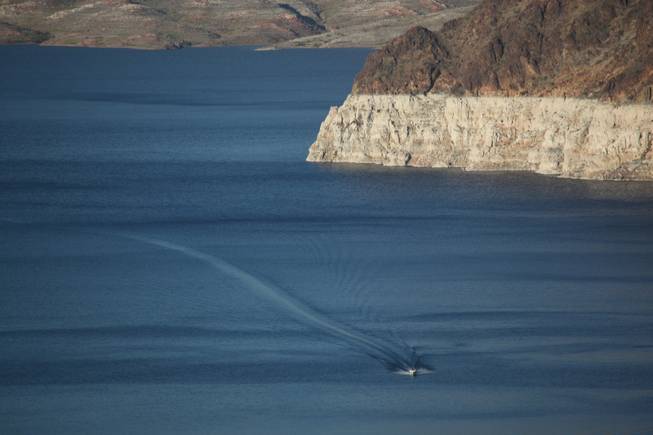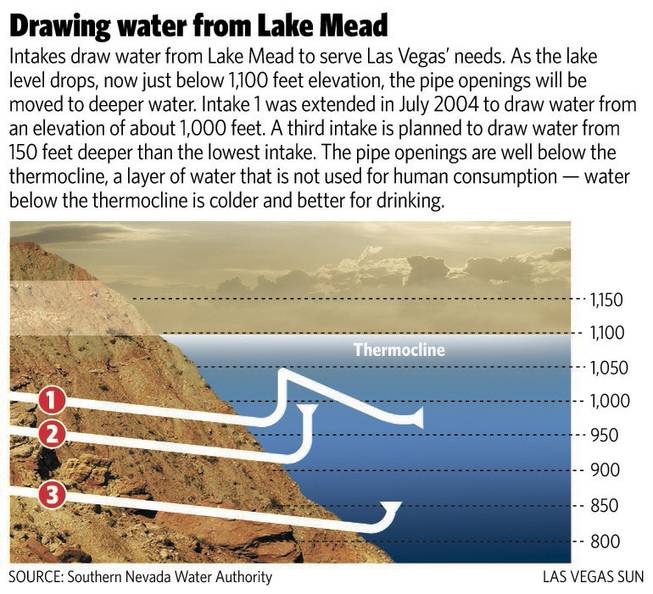
Officials will continue to monitor Lake Mead’s water level and valley water use to determine when a third pumping station will be needed.
Sunday, Sept. 13, 2009 | 2 a.m.
Reduced demand for water has allowed the Southern Nevada Water Authority to scale back its third intake project at Lake Mead, reducing the cost by $296 million — for now anyway.
A pumping station to pull water through what is more commonly referred to as the water authority’s “third straw” has been put on hold because engineers think the pump on the second intake, the “second straw,” can do the job at current demand, water authority spokesman J.C. Davis said.
As a result, the $817 million project has become a $521 million one.
The big winner on this is Boulder City, because the town’s share of the bill is being cut almost in half — to $13.6 million instead of $26 million.
The third intake — basically a tunnel being bored under the lake to draw water from its depths — is necessary because water levels at Lake Mead have dropped so much that water officials fear the original intake, built in 1971, will stop working.
If the surface of the lake drops to 1,050 feet above sea level, the original intake will not be able to draw water, Davis said. On Friday, the top of the lake was at 1,096 feet above sea level.
The second intake by itself will not draw enough to get Las Vegas’ share of Colorado River water out of the lake, but the pump that draws water through the second intake can pull enough water through both intakes to meet current peak demands, Davis said.
A connecting tunnel is being built between the second and third intakes to make the pump more efficient.
Engineers took a fresh look at the whole project in light of Southern Nevada’s reduced use of Colorado River water from the lake and the drop-off in region’s population boom. Engineers “realized we could put off the third pumping station for a while,” Davis said.
That decision doesn’t mean that Las Vegas Valley residents will see any reduction in their water bills, though.
Henderson, North Las Vegas and the Las Vegas Valley Water District — the other members of the Southern Nevada Water Authority — have been paying their shares of the water authority’s capital construction costs since 1994 through connection fees of about $5,000 for each new house.
But Boulder City, which limits the number of new homes that can be built per year, opted out of the connection fee, so it is being billed directly for its share of the third straw project — and hasn’t figured out yet how to come up with the money.
Boulder City voters in 2007 turned down a proposed land sale to raise the money, and since then City Manager Vicki Mayes and other city staff members have been looking for spare dollars during a budget crisis.
They found some in a federal grant from the Environmental Protection Agency that will kick in $485,000. To get the money, the city had to work with the water authority to isolate a smaller part of the project. That part is a water quality system to keep unwanted organisms out of the connecting tunnel between the second and third intakes.
Boulder City will pay $397,000 of the $1.8 million cost of that portion, with the federal grant and water authority picking up the remainder, Mayes said.
City officials are still in negotiations with the water authority regarding a payment plan for the rest of the $13.6 million bill.
Boulder City and the valley may not get to relish the reduction in the project’s cost for very long.
Water authority engineers are keeping a close eye on both the lake level and water demand and doing the complicated calculations that will determine at what point the additional pump would have to be built.


Join the Discussion:
Check this out for a full explanation of our conversion to the LiveFyre commenting system and instructions on how to sign up for an account.
Full comments policy